Inside The New York Botanical Garden
Programs and Events
Posted in Programs and Events on September 4 2008, by Plant Talk
  |
Written by Kate Murphy, a junior at Fordham University, with additional reporting by Genna Federico, a senior at St. John’s University. Both interned in the Communications Department this summer.
|
One of the great things about The New York Botanical Garden is that it is nestled in the borough of the Bronx. One way the Garden reaches out to the neighboring community is through the Bronx Green-Up program.
Since 1988 Bronx Green-Up staff have provided gardening advice, technical assistance, and training to community gardens, school groups, and other organizations interested in improving urban neighborhoods in the Bronx through greening projects.
It sounded like a way of spreading the beauty of gardening throughout the borough. So Genna and I decided to get out of the office and into the field to become Bronx Green-Up community garden volunteers for a day. First thing in the morning we piled into an NYBG pickup truck and headed off to the Morrisania section of the South Bronx. Our leaders were Director of Bronx Green-Up and Community Horticulture Ursula Chanse, Community Horticulturalist Sara Katz, and intern Kris Lau.
Read about the rest of Kate and Genna’s adventures after the jump.
Read More
Posted in Programs and Events on August 29 2008, by Plant Talk
  |
Written by Kate Murphy, a junior at Fordham University, with additional reporting by Genna Federico, a senior at St. John’s University. Both interned in the Communications Department this summer. |
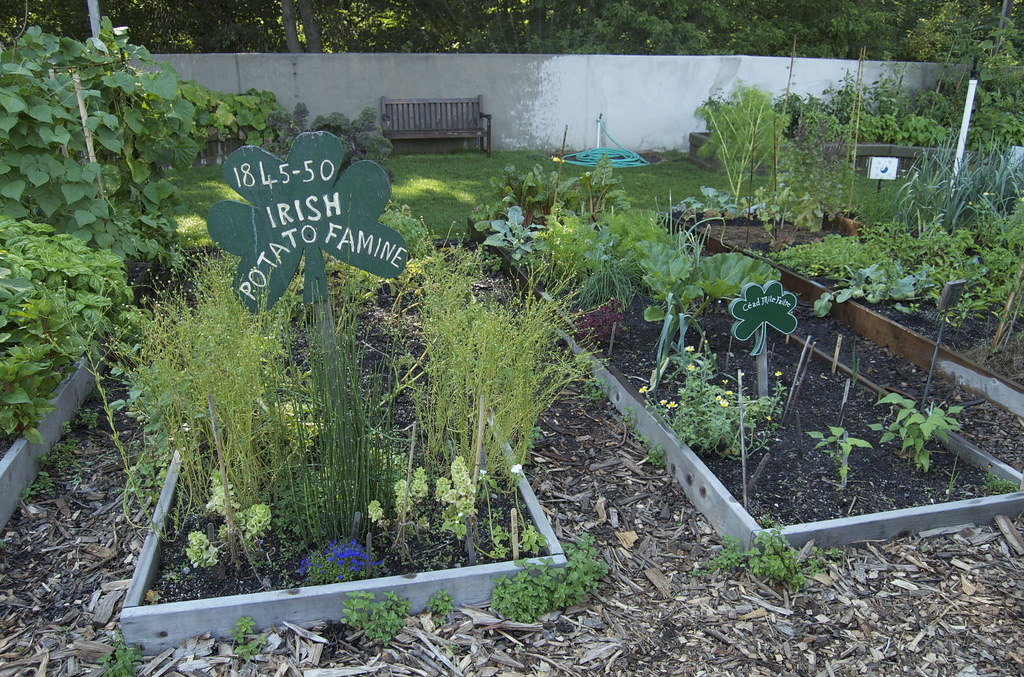 Taking a walk through the Global Gardens is like taking an international journey—minus the need for a passport and visit to Customs). NYBG visitors can drift from China to the Caribbean to Italy—in garden form, that is. And as summer (sadly) comes to a close so, too, does the celebration of the Global Gardens that has been going on all this month at the Ruth Rea Howell Family Garden. This, the final weekend of the celebration, will be dedicated to the Irish Garden, planted and maintained by Ann Creaney.
Taking a walk through the Global Gardens is like taking an international journey—minus the need for a passport and visit to Customs). NYBG visitors can drift from China to the Caribbean to Italy—in garden form, that is. And as summer (sadly) comes to a close so, too, does the celebration of the Global Gardens that has been going on all this month at the Ruth Rea Howell Family Garden. This, the final weekend of the celebration, will be dedicated to the Irish Garden, planted and maintained by Ann Creaney.
Ann became familiar with Irish gardening from first-hand experience, and her story is an interesting one, to say the least. In the early 1940s young Ann and her family visited her grandmother in Ireland. But when they were to return to America, the waters they would have to traverse by boat had been set with mines because of the war. As a result, Ann ended up living the next seven years in Ireland, time spent with no electricity and no running water but lots of gardening experience.
Read more about Ann’s journey and check out the Shepherd’s Pie recipe after the jump.
Check out Saturday’s Programming.
Check out Sunday’s Programming.
Read More
Posted in Programs and Events on August 22 2008, by Plant Talk
 |
Jessica Blohm is Interpretive Specialist for Public Education. |
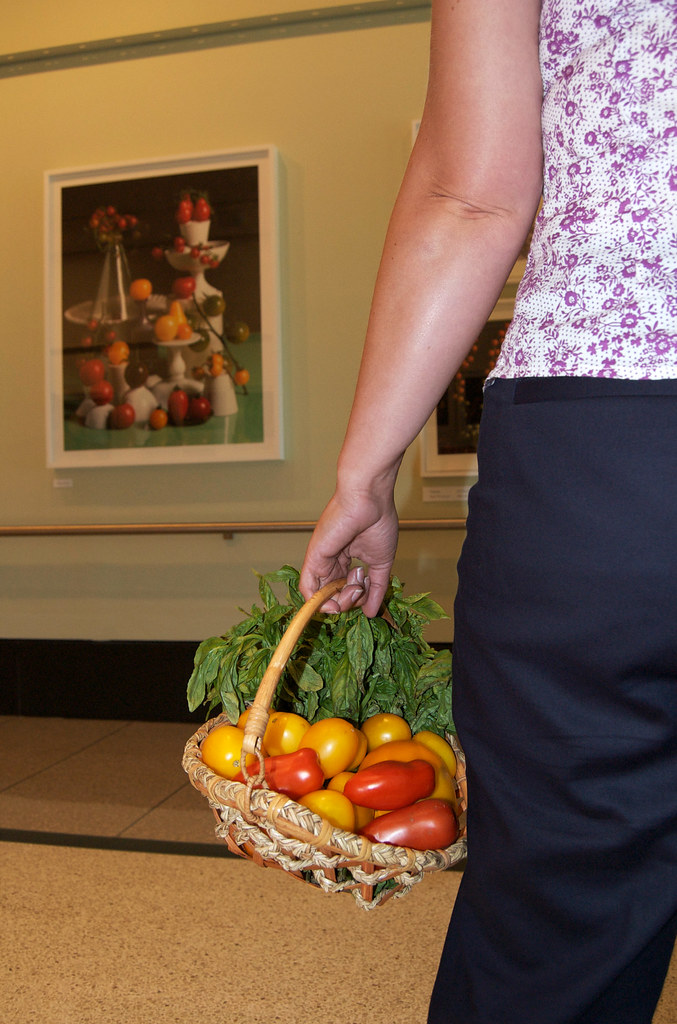 Jennifer Josef, Director of Public Education at the Garden, can’t wait for Wednesdays to roll around so that she can buy farm-fresh produce at the Garden’s Farmers Market.
Jennifer Josef, Director of Public Education at the Garden, can’t wait for Wednesdays to roll around so that she can buy farm-fresh produce at the Garden’s Farmers Market.
This week she bought several varieties of heirloom tomatoes and a big bunch of basil. The heirlooms seen at the market are similar to those depicted in Victor Schrager’s photographs in The Heirloom Tomato, the new exhibit in the Arthur and Janet Ross Gallery, which was also featured in the August 2008 issue of Martha Stewart Living.
The images highlight heirloom tomato varieties grown by Amy Goldman, a self-described “vegetable rights activist” who works to preserve the agricultural heritage and genetic diversity of the world’s vegetables. Jenn visited the gallery to view Victor Schrager’s divine photographs after buying her own fresh produce.
Jenn’s family, originally from Agrigento, Sicily, in Italy, loves to make traditional Italian delights with heirloom tomatoes. After the jump are three tomato recipes that Jenn makes with her mother. Check out these classic Mama Josef summertime treats yourself and let us know how you like them!
Read More
Posted in Programs and Events on August 20 2008, by Plant Talk
  |
Kate Murphy, a junior at Fordham University, and Genna Federico, a senior at St. John’s University, interned in the Communications Department this summer. |
 The weekly Farmers Market not only features vendors with regionally grown produce and home-baked treats but also offers demonstrations on the first and last Wednesday of every month. We decided it would be fun to check out the demonstration on composting led by staff from our Bronx Green-Up program.
The weekly Farmers Market not only features vendors with regionally grown produce and home-baked treats but also offers demonstrations on the first and last Wednesday of every month. We decided it would be fun to check out the demonstration on composting led by staff from our Bronx Green-Up program.
The New York City Composting Guide The NYC Composting Guide describes composting as “the process of creating the ideal conditions for the rapid decomposition of organic materials.” In other words, it’s what happens in your pile of vegetable and fruit peels, garden waste, and raked leaves after tending it in a particular way for a while.
Our first stop was the composting table at the Farmers Market, where we found lots of free information and learned that there was hands-on experience to be had if we visited the Home Gardening Center’s composting station, a short walk away. There we met a group of students from Adlai E Stevenson High School in the Bronx who are part of New York City’s GreenThumb-certified summer program.
The students were here to learn about composting so that they could use it when planting and maintaining the more than 20 vegetable beds at the Stevenson campus community garden, where the students also learn how to cook with what they grow. These students have also planted gardens at a local elementary school and have worked with a local homeowners’ organization in planting trees in nearby neighborhoods as part of the MillionTreesNYC initiative. (The Garden is involved in this initiative, too.)
Want to know more about composting for your own garden? See the tips after the jump.
Read More
Posted in Programs and Events on August 15 2008, by Plant Talk
  |
Written by Genna Federico, a senior at St. John’s University, with additional reporting by Kate Murphy, a junior at Fordham University; both are interns working in the Communications Department this summer. |
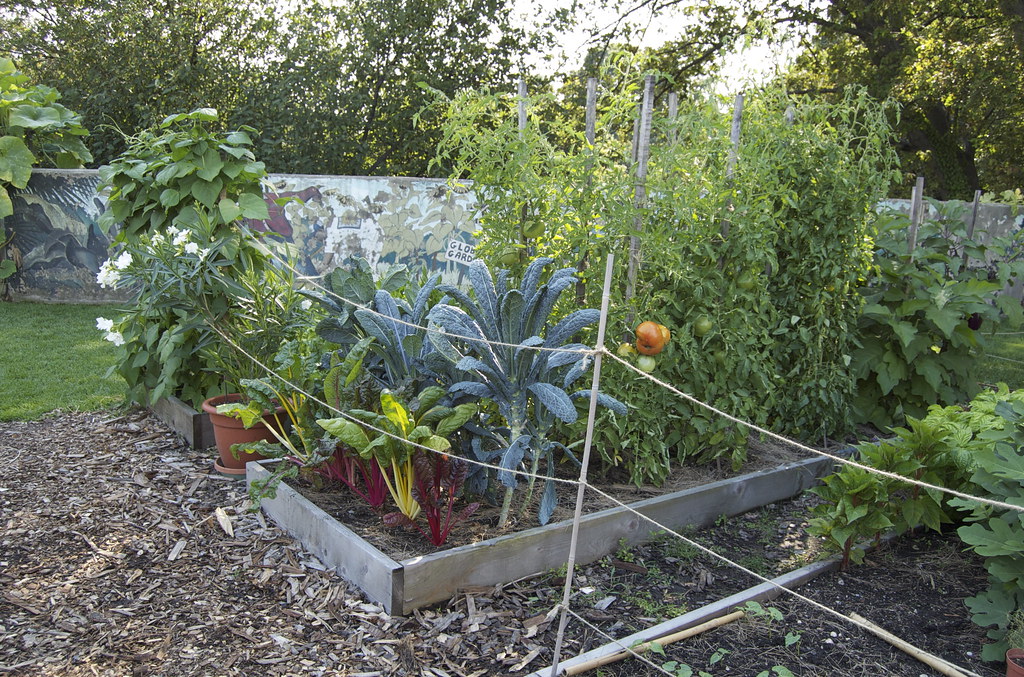 A few years ago, NYBG made Frank Russo “an offer he couldn’t refuse.”
A few years ago, NYBG made Frank Russo “an offer he couldn’t refuse.”
The Ruth Rea Howell Family Garden asked him to start an Italian Garden as part of its Global Gardens program. Russo had been volunteering in the Family Garden for about four years, so it was a natural fit.
The Global Gardens are planted and maintained by volunteers who take pride in the culture of the countries represented. Frank comes from an Italian background; his parents were born in Italy. But it was his grandparents who sparked his interest in gardening—growing up he liked to help them with their own garden.
At first Frank was hesitant to take on the job of the Italian Garden due to the maintenance required—indeed, during the summer months, he tends to the garden about four to five days a week. He knew it would mean a drastic change from the “come as you please” schedule he had enjoyed as a regular volunteer up until that point. But he soon accepted the challenge.
And he’s done a great job since. The garden is bountiful and full of fresh aromas. He tries to grow 100 percent of it from Italian seeds, most from Italy but also from Italian friends who have brought them over and passed them down to him.
Frank occasionally likes to change things up and try new varieties in the Italian Garden, now in its fourth season. This year he’s growing tomatoes, eggplants, escarole, arugula, string beans, chicory, garlic, basil, and even dandelions, the leaves of which can be used in salads, soups, or as a side dish.
The tomatoes are a sight to see! Colorful and juicy-looking, the seeds date back to 1910 and hold a special place in Frank’s heart. He has named them “Dominick” seeds after his grandson. Then there’s the basil; the leaves were immense and you could almost taste them from their intense aroma. We couldn’t leave without taking a sample of both of these delights home!
Frank makes sure his harvest never goes to waste and says he “absolutely” takes home the bounty to cook with. In fact, this weekend he will show off his culinary excellence at the Italian Garden celebration in the Family Garden, from 1 to 5:30 p.m.
When Frank isn’t at the garden or cooking up its harvest, he enjoys a meal out on famed Arthur Avenue, right here in our neighborhood. His favorite spots include Café Roma and Rigoletto.
Posted in Programs and Events on August 14 2008, by Plant Talk
 |
Kate Murphy, a junior at Fordham University, is an intern working in the Communications Department this summer. |
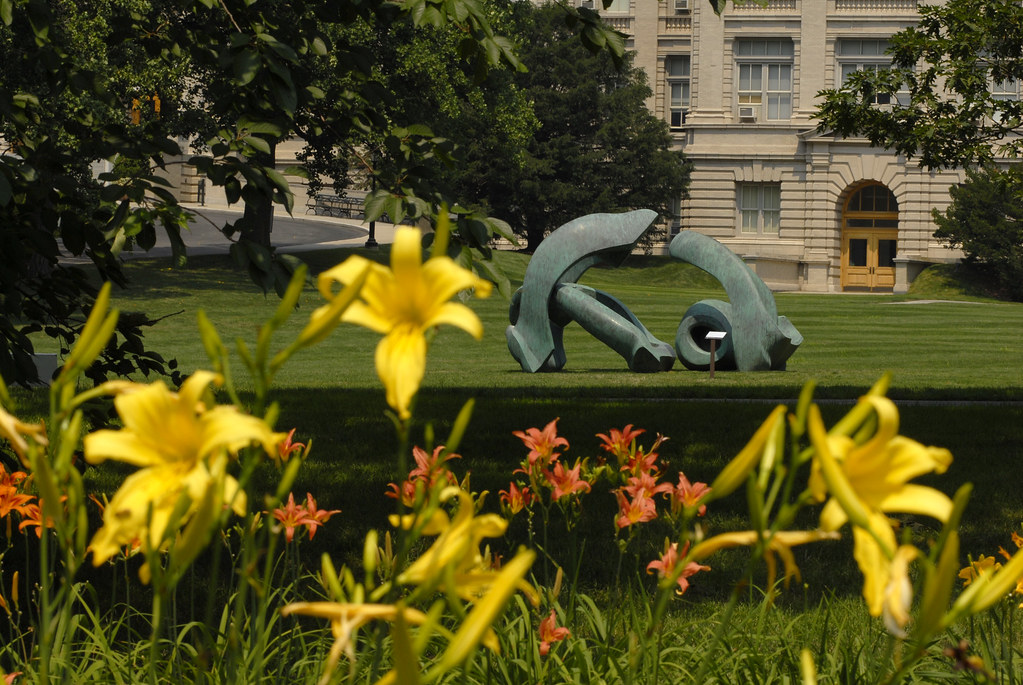 When I think of summer, I think of two things: heat and sun. And while I like a summer day just as much as the next person, I prefer summer nights. You get all of the beauty of summer without the humidity and sun in your eyes. So when I heard about the August concert series Evenings at the Garden, I knew I would have to check it out. The first concert, held August 7, featured classical guitarist Mattias Jacobsson and violinist Kristin Lee.
When I think of summer, I think of two things: heat and sun. And while I like a summer day just as much as the next person, I prefer summer nights. You get all of the beauty of summer without the humidity and sun in your eyes. So when I heard about the August concert series Evenings at the Garden, I knew I would have to check it out. The first concert, held August 7, featured classical guitarist Mattias Jacobsson and violinist Kristin Lee.
Mattias Jacobsson is classically trained. He studied at both the Malmö Academy of Music, in his home country of Sweden, and the Julliard School, here in New York City. His co-performer, Kristin Lee, also has Julliard experience: She has been there for over a decade, beginning with pre-college programs, and will continue studying the violin in its Masters program this fall. The two met at a birthday party where they both were performing; their concert at the Garden marked the first occasion in which they have performed together.
Their instruments blended seamlessly—classical music that was accessible to people of all ages. Crowds peppered the lawns of Tulip Tree Allée as the two performed pieces from Bach to Piazzolla, all within view of two of Henry Moore’s sculpture: Knife Edge Two Piece and Hill Arches.
In addition to the concert, attendees were free to roam the Garden Grounds until 8 p.m.—a rare opportunity to experience everything the Garden has to offer, from the Enid A. Haupt Conservatory to Shop in the Garden, at night!
It’s not too late to experience Evenings at the Garden. There are two more concerts scheduled: The Trinity Singers led by Owen Burdick will perform this evening, August 14, and next week, August 21, jazz with the David Grossman Ensemble is featured. Both concerts begin at 7 p.m.
Posted in Programs and Events on August 8 2008, by Plant Talk
 |
Jessica Blohm is Interpretive Specialist for Public Education. |
Clearly the theme of the week is color!
Obviously there are tons of flowers in bloom at the Garden with magnificent color!
Look for red roses, orange zinnias, yellow daylilies, green ferns, blue hydrangeas, and purple salvia.
OMG, you have got to get down to the garden to see all this beautifulness.
Really, you wrote an acrostic about color?
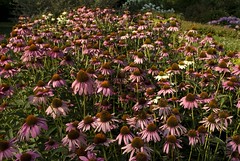 Not only are there plenty of colors to see at the Garden, but there are also exhibitions and workshops involving color. For instance, this weekend Sonia Uyterhoeven will explore the color wheel during her Home Gardening Demonstration, Celebrating Color and Form in the Garden, which will help gardeners find effective color combinations for their own gardens. Also, the exhibit Shapes of Nature in the Summer Garden, in the Enid A. Haupt Conservatory, features many varieties and colors of coleus and caladium, providing inspiration to gardeners looking to add color to those shady garden spots.
Not only are there plenty of colors to see at the Garden, but there are also exhibitions and workshops involving color. For instance, this weekend Sonia Uyterhoeven will explore the color wheel during her Home Gardening Demonstration, Celebrating Color and Form in the Garden, which will help gardeners find effective color combinations for their own gardens. Also, the exhibit Shapes of Nature in the Summer Garden, in the Enid A. Haupt Conservatory, features many varieties and colors of coleus and caladium, providing inspiration to gardeners looking to add color to those shady garden spots.
And clearly, the many fabulous Henry Moore programs that are going on at the Garden should not be forgotten; as Kate Murphy, our Communications intern says, “There is always more Moore.”
For a full schedule of this weekend’s programming, click on the links below. And for a totally fun look at color in a different way, see Disney cartoon character Ludwig Von Drake talk about the topic these YouTube videos: “The Wonderful World Of Color” and “The Spectrum Song.”
Saturday’s Events
Sunday’s Events
Posted in Programs and Events on August 7 2008, by Plant Talk
  |
Written by Kate Murphy, a junior at Fordham University, with additional reporting by Genna Federico, a senior at St. John’s University; both are interns working in the Communications Department this summer. |
The 2008 Olympic Games open tomorrow in Beijing. And though China’s capital and second largest city seems a world away, you might be surprised to learn you can find a little bit of China right here at The New York Botanical Garden.
The Ruth Rea Howell Family Garden features a collection of Global Gardens—gardens planted and tended by volunteers in the spirit of different cultures and countries. Shirley Cheung, along with her husband, Frank, and her mother, Mrs. Miu, has maintained the Chinese Garden for over 15 years. As a schoolteacher, Shirley gets the summers off and likes to tend the Chinese Garden every day. She and her husband try to come in the early morning, usually before seven, to beat the heat.
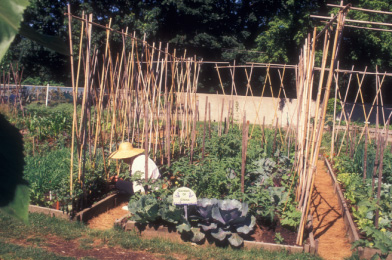 The Chinese Garden contains plants both for show and for cooking, but Shirley prefers the latter, using almost everything she grows in her own kitchen. She likes to grow new things every year: This year they’re harvesting kohlrabi, a cultivar of cabbage, which she explains is popular in China and grows easily here. The leaves of kohlrabi, which cannot be found in food markets because they are discarded before being sold, are good for digestion. She suggests growing your own kohlrabi and steeping the leaves to make a tea for this purpose.
The Chinese Garden contains plants both for show and for cooking, but Shirley prefers the latter, using almost everything she grows in her own kitchen. She likes to grow new things every year: This year they’re harvesting kohlrabi, a cultivar of cabbage, which she explains is popular in China and grows easily here. The leaves of kohlrabi, which cannot be found in food markets because they are discarded before being sold, are good for digestion. She suggests growing your own kohlrabi and steeping the leaves to make a tea for this purpose.
Another plant you’ll have to grow at home if you want to enjoy Shirley’s recommendation is garlic. While most everyone can find garlic at a local supermarket, the green tops are harder to find. Shirley insists that this is the best part and tastes great on chicken or fish.
The Chinese Garden also contains three different kinds of beans, tomatoes weighing in at over two pounds, and bitter melon, a fruit that in China is said to “cure 100 diseases.” Another highlight is the pumpkin flower, which can be picked, dipped in egg batter, fried, and enjoyed as a delicious treat.
Shirley calls the Chinese Garden her “paradise,” and her doctor told her to continue, because it’s keeping her young.
“It’s a lot of work, but a lot of fun,” Shirley says. “It’s the best life you can have!”
Posted in Programs and Events on August 1 2008, by Plant Talk
 |
Jessica Blohm is Interpretive Specialist for Public Education. |
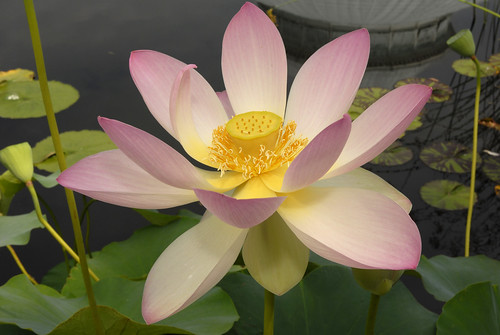 This week, while planning the upcoming fall Kiku (Japanese chrysanthemum) exhibit, I came across the lotus flowers that are blooming in the aquatic gardens of the Enid A. Haupt Conservatory Courtyard pools. Thinking about the role that kiku plays in Japanese culture got me thinking about the meaning of the lotus in other cultures.
This week, while planning the upcoming fall Kiku (Japanese chrysanthemum) exhibit, I came across the lotus flowers that are blooming in the aquatic gardens of the Enid A. Haupt Conservatory Courtyard pools. Thinking about the role that kiku plays in Japanese culture got me thinking about the meaning of the lotus in other cultures.
After doing a bit of research I discovered that throughout history people all over the world have valued the lotus for a variety of reasons. For instance, the lotus flower signifies purity and peace to the people of India, who consider the lotus to be sacred. In China the lotus flower represents a kind person who keeps pure and clean. To Buddhists the lotus flower symbolizes enlightenment, and in Egypt the seeds of the lotus flower are used to make bread.
I am fascinated by the techniques used to care for and maintain lotus plants. If you want to learn to grow and nurture these and other aquatic plants, you should attend this weekend’s Home Gardening Demonstration, “The Incomparable Lotus and Waterlily,” presented by Sonia Uyterhoeven, Gardener for Public Education. Who knows? You, too, may discover the meaning of the lotus!
There are lots of other activities taking place at the Garden this weekend as well: a plethora of popular Henry Moore activities such as walking tours, film screenings, and children’s tours (P.S. It was Henry Moore’s 110th birthday this past Wednesday.) If you are looking for an event that will entertain the entire family, visit the Global Gardens in the Ruth Rea Howell Family Garden, where you can participate in cultural crafts and activities and sample special regional foods—homegrown produce and native recipes.
Saturday’s Programming
Sunday’s Programming
Posted in Exhibitions, Moore in America, Programs and Events on July 25 2008, by Kate
 |
Kate Murphy, a junior at Fordham University, is an intern working in the Communications Department this summer. |
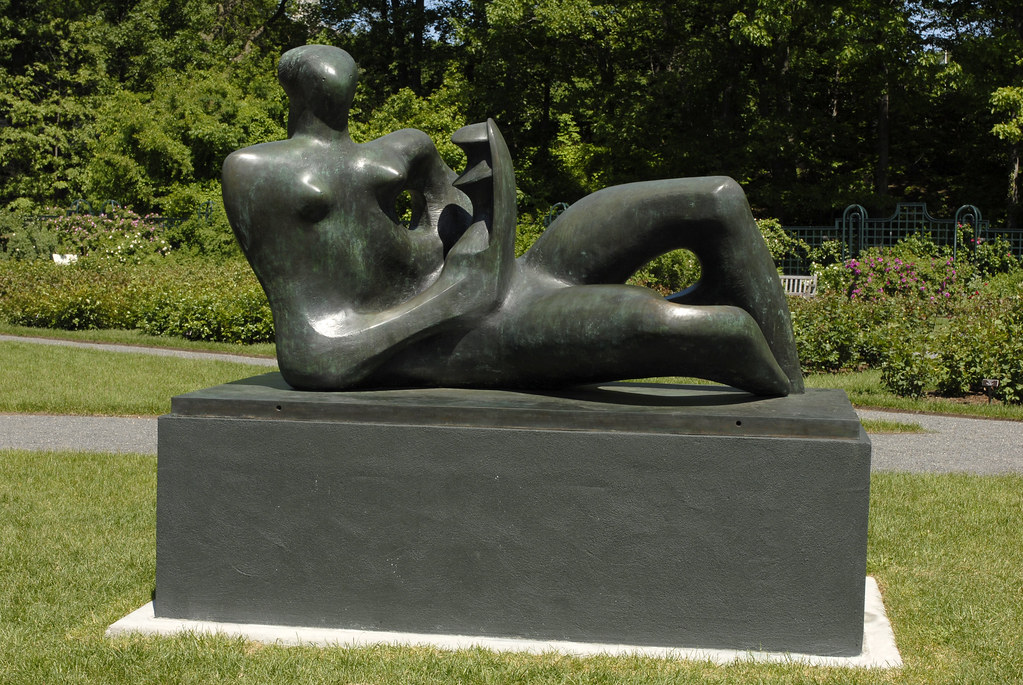
If the 20 monumental pieces in the largest outdoor exhibition of Henry Moore’s sculpture ever seen in a single venue in the United States isn’t enough for you, there is more Moore to be seen at NYBG. Every Friday, Saturday, and Sunday through November 2, you can catch The Art of Henry Moore, a documentary film focusing on his work.
As anyone living in or visiting New York City in the past few weeks-scratch that, during the summertime in general-will understand, the heat can get pretty intense. So I decided to escape to the Arthur and Janet Ross Lecture Hall and check out The Art of Henry Moore for some air-conditioned relief.
Narrated by Moore himself, the film features footage from around the world, showcasing a variety of backdrops for his magnificent sculpture, many of which can be seen in real life at NYBG during the Moore in America exhibit.
The Art of Henry Moore opens with Moore telling about his life and the defining moments that led him to become one of the most widely known and highly regarded sculptors of all time. He drew inspiration from a range of objects: from a bleak rock in the landscape of Adel woods, outside of Leeds, to ancient Mexican art found in the British Museum. He explains the themes in his works such as the mother and child and the reclining figure and considers the benefits of working in various media using different techniques.
Before seeing the movie, I didn’t know much about Moore’s creative thought process. I gained an appreciation for how artists, and Moore in particular, use particular methods for generating ideas. Moore talks of walking in nature every day and how a sculpture begins—by finding an object such as a bone or a pebble and drawing and studying it. Moore took these “found objects” and translated the beauty of imperfection into his abstract sculpture.
I would definitely recommend seeing The Art of Henry Moore when you visit the Garden for the Moore exhibition. It puts all of the work in perspective and puts a human face on the man behind the extraordinary sculpture.
Saturday’s Programming
Sunday’s Programming












